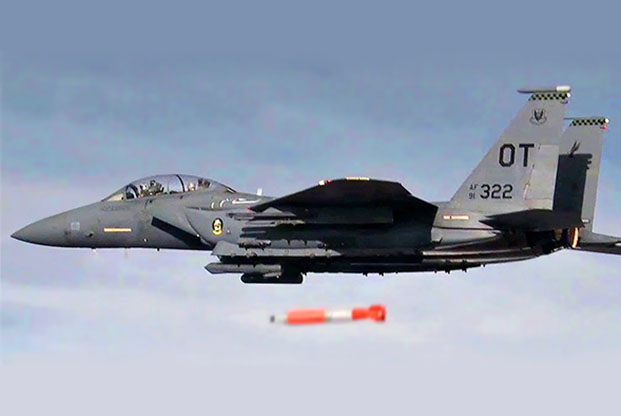
A B61-12 test unit is dropped from an F-15E during a development flight test in 2015. Photo: National Nuclear Security Administration
“We must modernize and rebuild our nuclear arsenal, hopefully never having to use it, but making it so strong and powerful that it will deter any acts of aggression,” President Donald Trump asserted in his February 2018 State of the Union address.
“Perhaps someday in the future there will be a magical moment when the countries of the world will get together to eliminate their nuclear weapons,” he continued. “Unfortunately, we are not there yet.”
Former President Barack Obama’s vision, articulated in Prague in 2009, was to put nuclear disarmament first while maintaining a credible arsenal.
Trump’s vision reverses this and says strengthen the nuclear arsenal first.
What happened in the intervening nine years? Russia happened.
When Obama was elected, hopes ran high that Russia would evolve into a peaceful actor. As the 2010 Nuclear Posture Review put it, “Russia is not an enemy and is increasingly a partner.”
The New START agreement, signed that year by Obama and then-Russian President Dmitri Medvedev, limits the US and Russia to 1,550 deployed strategic launchers through February 2021.
Things have gone downhill since then. Russia, China, Iran, and North Korea are not interested in following the US lead on nuclear reductions. They are brutally self-interested and see much to gain by improving their own nuclear forces.
_Read this story in our print issue:
In 2014, Russia invaded Ukraine and illegally seized Crimea. It steadily ramped up rhetoric and aggression toward its neighbors and the United States and repeatedly violated arms control agreements and international law. “We must look reality in the eye and see the world as it is, not as we wish it to be,” Defense Secretary James Mattis wrote in his introduction to the NPR.
In response, the NPR lays out specific force-structure plans. Ohio-class nuclear missile subs will be replaced by next generation Columbia-class boomers; the Ground-Based Strategic Deterrent (GBSD) will begin replacing Minuteman III ICBMs; the next generation B-21 bomber will supplant the B-2 stealth bomber; and Long-Range Standoff (LRSO) cruise missiles will replace old Air-Launched Cruise Missiles.
The National Nuclear Security Administration (NNSA), which ensures the safety, security, and effectiveness of nuclear weapons, is accelerating some programs begun under Obama. NNSA is modernizing warheads and developing the B61-12 nuclear bomb to consolidate multiple old weapons and offer greater accuracy and reliability.
The US will also develop new, lower-yield nuclear cruise missiles for Navy use and will shorten the time needed to conduct a “live” nuclear test.
America’s “test readiness posture has not changed,” said USAF Brig. Gen. Michael J. Lutton, who is responsible for military application at NNSA. Little “t” testing takes place all the time, Lutton noted. Examples include flight-testing weapons and performing stockpile stewardship computer simulations.
There are no plans to conduct an actual nuclear test, as the US has had a self-imposed “Big T” testing moratorium in place since 1992.
“The United States remains committed to its efforts in support of the ultimate global elimination of nuclear, biological, and chemical weapons,” the NPR reads. The US has reduced its nuclear stockpile from a peak of 31,000 weapons to 4,000 and has deployed no new nuclear capabilities in two decades.
Still, antinuclear critics are beside themselves. In a masterstroke of hyperbole, the Bulletin of the Atomic Scientists this year moved its “Doomsday Clock,” which “warns the public about how close we are to destroying our world with dangerous technologies of our own making,” to two minutes to midnight. This is “the closest the Clock has ever been to Doomsday.”
Similarly, Sen. Diane Feinstein (D-Calif.) said the NPR “lowers the threshold for use of nuclear weapons,” repeating a canard that seemingly resurfaces with every new nuclear review or strategy.
If the only options are unusable nuclear weapons, “are we then back to the doctrine of massive retaliation, from which every American administration since the 1950s has sought to escape because of the lack of credibility of the choice it posed between suicide and surrender?” asked Henry Kissinger … in 1990.
People see what they want to see in this NPR. The review is short on hope, long on reality. It offers exactly the nuclear roadmap the US needs right now.
“I hope everyone understands that it is better to not mess with Russia,” Putin bluntly stated in August 2014, in the midst of his invasion of Ukraine. “I have to remind you that Russia is a nuclear superpower.”
This “environment makes further progress toward nuclear arms reductions in the near-term extremely challenging,” Mattis wrote. “Ensuring our nuclear deterrent remains strong will provide the best opportunity for convincing other nuclear powers to engage in meaningful arms control initiatives.”
New START expires in 2021. The US should pursue an advantageous new arms control agreement before then, but to do so it must negotiate from a position of strength.